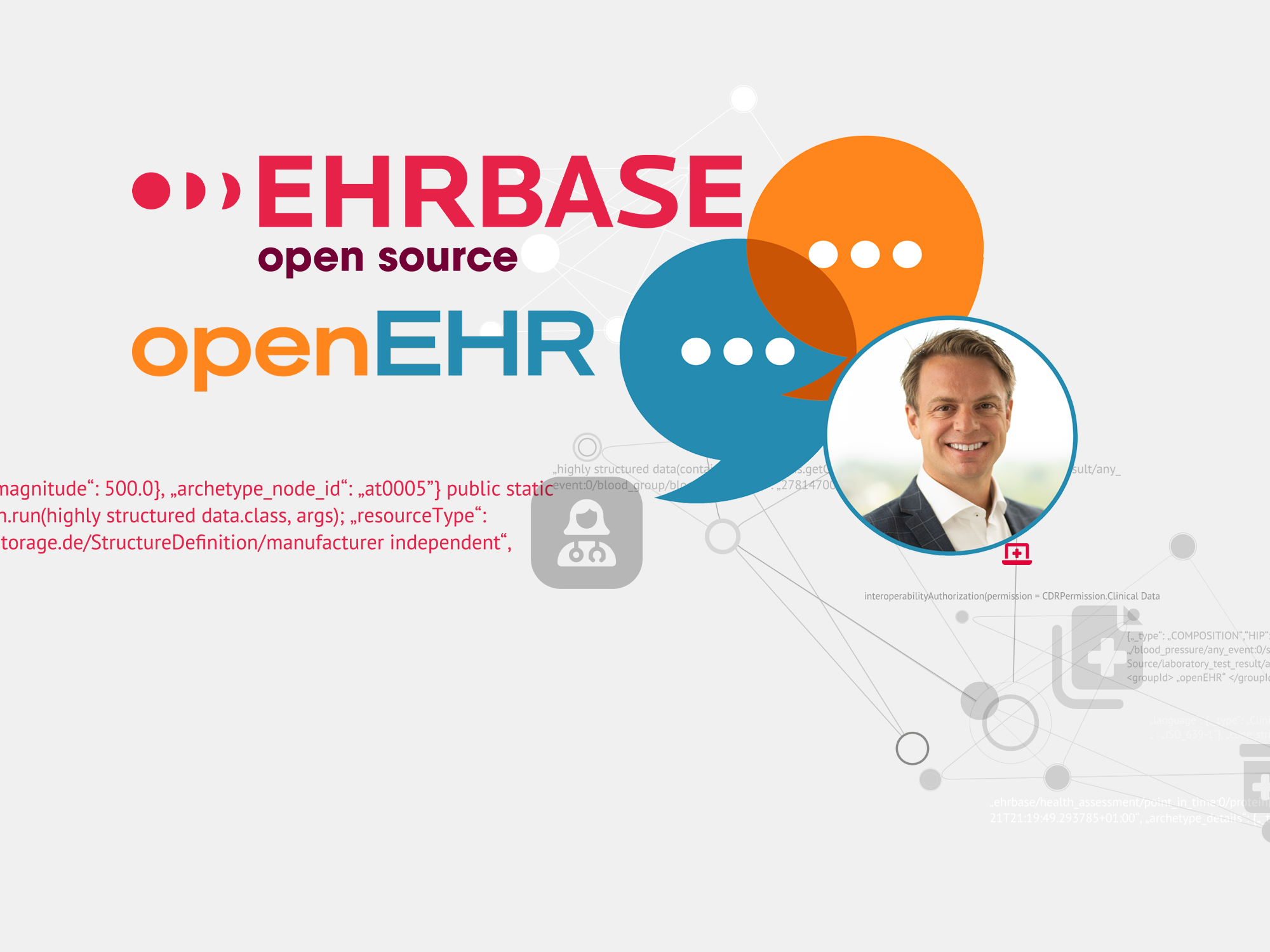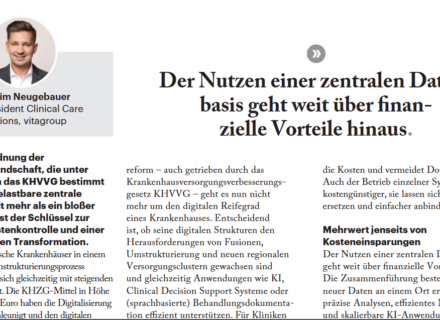openEHR Industry Partner interview
As Managing Director of vitagroup, Dr. Nils Hellrung plays a pivotal role in guiding the Health Intelligence Platform Division, focusing on innovative healthcare solutions and the critical importance of structured, high-quality data and interoperability. Originally from Berlin and now living in Brunswick, Nils spoke to us about his career journey, the evolution of vitagroup, and his vision for the future of healthcare technology.

My background
My name is Nils Hellrung. I’m a doctor of Medical Informatics, and also Managing Director and a Member of the Board of vitagroup AG. I come from Berlin, but currently I’m living in Brunswick. I first studied Business Engineering with Electronics, then I went to Canada for a year – this was around 2001 – where I was working for a company in which half of the business was medical, and half of the business was military.
After September 11, however, they completely changed and switched 100% to military, but at this time I really fell in love with helping health care systems with technology. I cannot imagine working in anything else.
After that, I went to Innsbruck in Austria, to the University for Medical Informatics in Tyrol. And from there, I came to Brunswick – not far from Berlin – which is where I’m living now. It seems everybody was working for Volkswagen, except me. I did my PhD here in medical informatics and then I founded a company, which I sold to vitagroup in 2018, and I’ve been with vitagroup ever since.
What vitagroup offers
vitagroup has around 400 people in the company, but it has two divisions. One is the so-called health dialogue. That’s where we are delivering health services to the citizens directly or for health insurance companies, for example telemedicine.
And the other half is the Health Intelligence Platform Division. That’s what we are talking here. And this division has about 120-130 people. It’s been a journey. When I came into the company, actually, they were doing everything and nothing, so it was very broad; everything in prevention, in elderly care, in telemedicine, so everything a little bit, but no focus. So that was part of my job, to really define the strategy and define focus.
I have spent so much time working on eHealth projects, and it was always the same. It’s like 40% in data security concepts, and 50% in interfaces, and 10% in the actual project. It’s always been the same, and everybody was frustrated, so when I got the chance to define a strategy, I said, ‘okay, I want to get to the core of the problem!’.
In Germany, still today, to be honest, politically, there’s still the thinking of, ‘it’s enough to connect the systems’. But for me… well, there’s an old saying in IT: ‘shit in, shit out’: an interface doesn’t make the data better, so you really have to define highly-structured, high-quality databases. It’s not a solution to connect legacy systems with proprietary data models.
The healthcare system in Germany is really fragmented, and it’s difficult to bring about the whole culture shift into collaboration. There is a very strong movement with FHIR which I think is a good thing, because we need FHIR and we use it a lot. FHIR is an integral part of our products, but it’s not enough. It’s not enough to have these narrow interfaces. It just makes no sense that everybody is defining the concept of, for example blood pressure, again and again for themselves. Everybody should understand this from my point of view, and be happy about the announcement of the collaboration between HL7 and openEHR, because for us, this was always the goal.
People have always said it’s either one or the other [FIHR or openEHR], but we’ve always maintained that’s not the case; we’ve never taken a dogmatic approach. Rather than putting one standard first, you have to ask yourself what you want to achieve. For us, we wanted to achieve a vendor-neutral way of persisting high quality, high structured data. So, we looked at the standards because it makes no sense to develop the data model by yourself, because then it’s not a vendor-neutral data model anymore.
We looked at the different options and compared FHIR and openEHR in that regard. You can do persistence with FHIR – of course we know that – but it has a lot of flaws and we are not the only ones who see it this way. So, we realised that openEHR was the best option, but very quickly that turned into a political debate. For us, it’s a technological, content-driven and goal-driven decision, and not something dogmatic. EY has put up a wonderful video explaining this.
We would never say that openEHR is the solution to everything: it isn’t. It’s a solution to a very concrete problem. We need to agree on how we should store the data, and have a discussion around the best processes or the best applications, but we shouldn’t compete about data models. That just makes sense.
New horizons
We’re also in a partnership with AWS, and our goal, of course, is to concentrate on the technology and provide the best ‘backend’ for open health data platforms. That’s what our portfolio targets. We’re really on the middle layer between infrastructure and applications, because the applications come mostly from partners. We want to concentrate on the data persistence and interoperability layer.
When we started around five years ago with the decision to not only connect systems but also to build up clinical data repositories, we were mainly looking at the DACH region – Germany, Austria and Switzerland. We were searching for the best technology to do this, and at the time, openEHR was just starting in Germany, only the medical informatics community had already heard of it.
Of course now openEHR has gained huge momentum, even more so outside Germany, for example in Spain, Scandinavia, Switzerland – basically everywhere in Europe. And so we need to find a way to scale internationally. We want to make it as easy and accessible as possible for our partners and customers to get the systems running. That’s why AWS is a perfect partner, because that’s what they are doing with the infrastructure: making technology like ours available globally.
The vitagroup product suite

There are three main products in the vitagroup portfolio. The first is EHRbase, which is open source. The goal of EHRbase is to let people around the world explore and play with openEHR. These can be people inside healthcare institutions or regions, or industrial partners. We want to make openEHR more accessible, so it’s an implementation of openEHR that’s completely open source.
Then there’s HIP EHRbase: HIP stands for Health Intelligence Platform. When we say “HIP,” we’re talking about our commercial product world. HIP EHRbase is EHRbase extended with modules so you can scale your health data infrastructure securely and safely. You shouldn’t go live with open source EHRbase alone for real patient data. If you did, you’d have to develop a lot of stuff yourself, like logging features, security and scalability features. We deliver these as commercial modules on top with HIP EHRbase. Catalunya, for example, uses HIP EHRbase. We deliver this mostly to technology partners or customers who have their own engineering staff, because they still need to develop things around it, like processes and integration features.
HIP Clinical Data Repository (HIP CDR) is our flagship product. It’s more than just an openEHR persistence layer. HIP EHRbase is part of HIP CDR, but we also have a full-blown FHIR store in it. We use FHIR and other standards for integration.
The next important module in the HIP CDR is the CDR Bridge. We have a complete integration layer in that product. We also have additional modules like a patient viewer and means to access the data and build processes over APIs.
So, the HIP CDR is actually a complete data backend platform, whereas HIP EHRbase is a commercial version of a pure openEHR system. The open-source EHRbase is something you can use for free to start with. But once you really go live on a larger scale, you should use HIP EHRbase.
So in some ways, you could describe EHRbase as a kind of sandbox that people – including developing countries and developing health systems – can use, to see if it works for them.
For example, Jamaica is building their national patient record based on EHRbase. There are a lot of projects around the world going on and there’s quite an active community. You can download EHRbase from GitHub. There’s no barrier between somebody who wants to download it and us, you don’t have to register anywhere and we don’t monitor who’s using EHRbase around the world, but we’re setting up a new version on AWS, a real sandbox. Not the kind where you have to download and install the stuff yourself, but a one-click solution that lets you really start within five minutes to try it out.
And now we’ve produced EHRbase 2, which is a better version. The most important part that we modernised was the so-called AQA engine. That’s the part that is responsible for retrieving data from the EHRbase: how you access data, how you search for it, and how you get data out of it.
Looking ahead with openEHR
openEHR seems to have really grown over the last year, and we work in a very tight, close-knit community. Everyone’s kind of helping each other along, but there’s still an element of competition between the big companies in the sector.
But I really believe in the necessity of separating the different layers of an architecture. So the infrastructure, then the data layer where we are, then the processes and the front ends, and of course I’m convinced of this strategy. For me, an open platform is one that enables the customer or partner to select different parts from different venues.
So that’s why we are really focusing on separating the data; an open health platform is not only openEHR, first it’s open source in the core of it. And second, you really have to be able to use the back end without buying the front ends from the same vendors.
Otherwise, it’s just a hospital information system that is using openEHR. But for us, it’s really important to say, okay, if you want to just have the core of it, you don’t even have to buy the administration UIs from us. They are already separated, technically. So that’s the real difference for us – that we don’t have that vertical silo, but that we focus on the horizontal data layer.
The original interview appeared on openehr.com.



